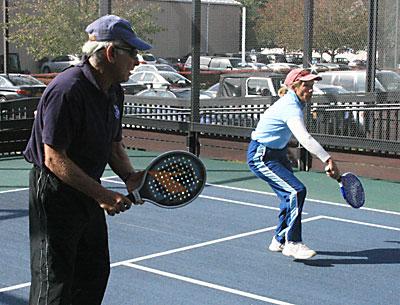Paddle Courts for the People at the Indoor-Outdoor Club

Two platform tennis courts were officially opened at the East Hampton Indoor-Outdoor Tennis Club this past weekend with well-attended clinics put on by Marco Grangeiro, the New York Athletic Club’s paddle director in Pelham, and Marie Minnick of East Hampton, who teaches the increasingly popular racket sport at four clubs on the South Fork.
Platform tennis, or “paddle,” as it is known colloquially, was last written about on the sports pages of this newspaper in March of 1978. That story, by Steve Bromley Jr., this writer’s predecessor as The Star’s sportswriter, was headlined “The Winter Game.”
“It remains a winter game basically,” said Scott Rubenstein, E.H.I.T.’s managing partner. “For paddle it’s better if it’s 25 degrees out than 50.” Though, since the courts (which have lights) were finished a month or two ago, they’ve been getting quite a bit of play no matter what the weather.
“I got the idea,” said Rubenstein, when questioned following Sunday morning’s clinic, “when I heard our members were no longer able to play at the clubs here that had courts. Seven years ago, things opened up and everybody was playing. Then, about three years ago, our members, who had been playing as guests, were asked to leave. That’s when I thought it would be nice to have our own courts and to open them up to the public. . . . I’m a strong believer that there should be more recreation here for everyone of all ages.”
Paddle is a doubles serve-and-volley game, though the lob, Grangeiro stressed, is “the most aggressive stroke.”
“Ninety-five percent of the time,” said Minnick, who is the fourth-ranked mixed over-60s player in the country and the reigning over-50 Long Island champion, “the last one to hit the ball loses the point.”
The point being that in paddle, finesse and strategy trump power. As in squash, the court (four of them can fit into one tennis court, but are otherwise the same save that the net is two inches shorter) is bounded on all four sides — by chicken wire in platform tennis’s case, rather than laminated wood as is the case with squash. Which means that theoretically, a player skilled at playing the spongy ball off the wires can send up lobs all day.
While the lob is paddle’s most aggressive shot, the first volley, the clinic-givers said, is the most important. That volley, Grangeiro and Minnick said, ought to be hit with the paddle squarely in front of one’s chest with knees bent and with the feet square to the net. No lunging, no stabbing. Simply block it back.
Servers in paddle get only one chance, which concentrates the mind. Just get the ball in, Minnick and Grangeiro said, and follow the ball to the net as quickly as you can, taking up a position straddling the T with your partner closer to the net at your left or right, depending on the court — ad or deuce — into which you served.
This writer, a doubles tennis player these days who last picked up a platform tennis racket 30 or so years ago, was reminded during the clinic that the two games are, indeed, somewhat different. One needs to be more patient in paddle, for one thing, for it’s likely the rallies — assuming everyone can play the ball off the wires pretty well — will be longer. Aside from the first volley, all drives, lobs, overheads, and wire shots are to be hit from a sideways position. Backhand overheads are to be eschewed: only forehand overheads should be hit. Serve returners should favor their stronger stroke, and thus should, facing sideways and with their back toward a side screen, await the serve with one foot in the alley and one foot just beyond the baseline.
Moreover, in paddle you can’t get away with wristy shots, and, because the court is so much narrower, there are fewer angles to be exploited. In fact, partners can pretty much control the net, the clinic-givers said, by leaving the third of it diagonally opposite the striker open.
When lobbing, Minnick asked us to think that we were holding a frying pan in front of us, and to follow through smoothly into a Statue of Liberty pose — again, standing sideways, with the lead shoulder pointing toward where one wants the ball to go. “If I have a 6-4 partner,” the 5-foot-3 Minnick said, “you’ll want to lob over me.”
Rubenstein said that the club’s tennis members can play paddle for $300 seven days a week year-round, until 11 or so at night. For non-members that fee will be $500.
“There will be no court fees,” he said, “and we’ll help set up games, the same way we do in tennis.”
Moreover, there will be weekday paddle memberships costing $250 for E.H.I.T. members and $350 for non-members.
A warming hut between the courts, under which there are heaters to melt ice and snow, will have a microwave, toaster, refrigerator, hot chocolate, and coffee.
“It looks like there’s a lot of interest — it’s exciting,” said Rubenstein, who added that “the last time I played paddle was in 1978 with the late Sandy Ingraham. We played at the East Hampton Tennis Club. I was pretty confident, for I was good at tennis, table tennis, and racquetball. He trounced me — I didn’t win a point.”
“That was the last time I played,” he said with a smile, “though I may do it again.”
